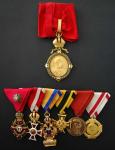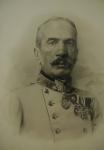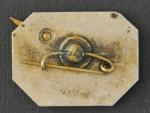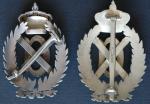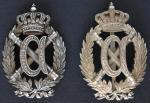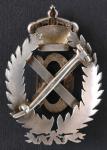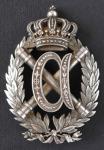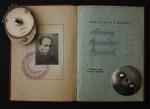-
Posts
1,161 -
Joined
-
Last visited
-
Days Won
17
Content Type
Profiles
Forums
Blogs
Gallery
Events
Store
Everything posted by Elmar Lang
-

Austria-Hungary A General with the "Literis et Artibus" Medal
Elmar Lang replied to Elmar Lang's topic in Austro-Hungarian Empire
-
Hello, one of my recent acquisitions, is this group of orders, medals and a portrait photograph of an Austrian General wearing, besides his "typical" orders and decorations, the oval, neck medal for arts and sciences, instituted on August 20th 1887. The decoration is in gold and black enamel; ring, crown and medal's suspension loop are struck with the old Austrian manufacturer's (Rothe) and gold marks. As a comparison, I add the picture of the medal, along with a French medal of the Archaeological Academy (this piece too, shows old Austrian marks). Does anyone have an idea on who's this general? Many thanks in advance, for any help and advise, Enzo
-
Hello, on Tamman's book, I see a "AK" mark for Andrei Antonovich Kovalskij, assayer in Moscow, 1821-1856. Best wishes, Enzo
-
Hello, Here's a strange (to me) test-pilot's badge, different from the usually known award: until now I had no success as to know what does the cyrillic acronym "ZPLS" mean. Any idea? Many thanks in advance, Enzo
-
Hello, actually, I don't know who was the designer of this badge: the Russian ispiration is quite evident, but I think the prototype came directly from Messrs. Rothe's workshop. Let's see if any further information would emerge. Regarding the copy, I've forgotten to give its measures: 61 x 42,8 mm. The piece shown in the picture was bought from me, directly at Rothe's in 1979, and it's silver-plated bronze. Rothe supplied copies in silver too (too expensive for a then young student!), and lately I've seen such copies emerge on the market, struck with fake "old-Austrian" silver and manufacturer's marks. In this short study, I've described the only copy made by the former manufacturer; there exist also cast copies, moulded from an original piece, but I think that they can't deceive even the beginner. Best wishes, Enzo
-

Austria-Hungary Ignaz Joseph SCHMIDT Wien Jeweller
Elmar Lang replied to Veteran's topic in Austro-Hungarian Empire
Hi Veteran, I see that both you and me had the privilege to know Prof. Fattovich and see his fine collection. I've studied in Venice, so it was easy to meet him. He was a real gentleman and, besides the collection, he had a huge library. He was always ready to give help and advise. I can say that if I've finally choosen to specialize my collection on Austria-Hungary, it was thank to him and his enthusiasm. Yes, the type with separate crown is rare (the one with oak leaves would be much, much more...). Best wishes, Enzo -
Hi Christian, first of all, thank you very much for the information!, Now I'll go and look for Yudin's biography in "Kavalerij Ordena Slavy Trekh Stepeney", Moscow, Voyennizdat, 2000. Thank you too for the further reference. I've bought the piece back in 1993 in Milan, at the "Militalia" militaria show for 900.000,- Lire (approx. 450,- Euro). The piece shows a lot of wear and a point is even slightly bent, but I agree, the patina and overall appearance are highly attractive. Another question: what type of gold is that of the Slava 1st Class? I mean if 18, 22 or 24 Carats... Thank you again and best wishes, Enzo
-
And now, last but not least, the comparative images of the original piece with the copy of Rothe & Neffe, made after 1918. One of these copies is already illustrated on Michetschlager's "Das Ordensbuch der gewesenen Oesterreichisch-Ungarischen Monarchie" from 1919. The same type of copy, is illustrated also in Mericka and Prochazka. What's very visible, is the different angle of the batons' crossing, 90? for the original piece, and more "elongated" for the copy. Note that the copy, although differently "assembled" is made with the original dies. The original is at left. Obverse:
-
Hello, I think it could be useful for us all, a brief description of this very rare piece, then compared to the most encountered copy of it. This is a rather unique type of decoration -for Austria- because most commemorative signs were in the form of medals and/or crosses. On May 21st 1899, the Emperor Franz Joseph addressed a handwriting to General Piret de Bihain, expressing the idea to create a commemorative badge "to be worn on the right side of the breast" (...auf der rechten Brustseite zu tragen...). The very well known Jewellers Rothe prepared the prototypes and the one approved consisted of an oval laurel wreath superimposed with two crossed marshal's batons, and the crowned monogram "A" (for "Albrecht"); the fastening pin is diagonal. The original badge measures 59 x 41 mm; the material is silver. At the Austrian State Archive - Kriegsarchiv, it is preserved the transcription of the Emperor's decree and the list of the Officer's of the late Archduke's military entourage, comprising 33 names. The list was lately added with 4 further names. The german text of the institution's decree (from the copy at the Kriegsarchiv): Abschrift eines Allerh?chsten Handschreibens vom 21. Mai 1899 an den General der Cavallerie Eugen Freiherr Piret de Bihain. _____________________ Lieber General der Cavallerie Freiherr von Piret.Sie haben an der Spitze jener wenigen noch lebenden Officiere, welche sich des Vorzuges r?hmen d?rfen dem verewigten Feldmarschall Erzherzog Albrecht in pers?nlicher Dienstleistung nahe gewesen zu sein. Angesichts das Standbildes des Erzherzog-Feldmarschalls, will Ich dieser Auserlesenen anerkennend gedenken, indem Ich denselben ein ?Erinnerungszeichen? verleihe, welches auf der rechten Brustseite zu tragen ist. Wien, am 21. Mai 1899 Franz Joseph m./p. ...and this is the recipient's list (also from the data at the Kriegsarchiv): Verzeichnis Zu N.? 1171 v. 1899 M.K.S.M. General der Kavallerie Eugen Freiherr Piret de Bihain Feldzeugmeister Philipp Graf Gr?nne Feldzeugmeister Zeno Graf Welsersheimb General der Cavallerie Andreas Graf P?lffy ab Erd?d General der Cavallerie Hilbert Freiherr von L?hneisen Feldmarschall-Lieutnant Victor Graf Dubsky von Trzebomislitz Feldmarschall-Lieutnant Alois Graf Paar Feldmarschall-Lieutnant Franz Sch?naich Feldmarschall-Lieutnant Anton Freiherr von Malowetz Feldmarschall-Lieutnant Johann Groller von Mildensee Feldmarschall-Lieutnant Ferdinand Freiherr von Franz Feldmarschall-Lieutnant Wladimir Freiherr von Spinette Generalmajor Guido Graf Dubsky von Trzebomislitz Generalmajor Ludwig Fischer-Colbric Generalmajor Stephan Szmrecs?nyi de Szmrecs?ny Generalmajor Wilhelm Graf Palffy-Daun ab Erd?d F?rst von Teano Oberst Ludwig Graf Breda Oberst a.D. Ernst Graf Chotek Oberst Viktor von Koller Oberst d.R. Lothar Freiherr von Hennet Oberst Josef Fajta Oberstlieutnant Theodor Hanke Oberstlieutnant d.R. Johann Freiherr von Bavier Major a.D. Emerich Kohl Major a.D. Franz Graf Lamberg Major in der Res. Ferdinand Prinz Lobkowitz Major a.D. Franz Graf Thun-Hohenstein Major a.D. Johann F?rst Khevenh?ller Hauptmann Anton Wahl Rittmeister a.D. Gabriel Graf Festetics Rittmeister d. Ung. Ldw. Nikolaus F?rst P?lffy ab Erd?d Oberlieutnant i.d.Res. Johann Prinz zu Schwarzenberg Stabsarzt Doctor Eduard Ritter von H?bl-Stollenbach (names added later to the list, with a different calligraphy): FZM Heinrich Freih. von Beck Oberlieut. a.D. Max Freiherr von Redwitz Oberstlieut. d.R. Rudolf M?riany de Markus et Datisfalva Major der Ung. Ldw. Zoltan Szabo. Now, the pictures of the original badge: Obverse:
-

Austria-Hungary Ignaz Joseph SCHMIDT Wien Jeweller
Elmar Lang replied to Veteran's topic in Austro-Hungarian Empire
Hi Veteran, the Leopold you've posted is an extremely fine, early piece. Yes, the ribbon is a combination of the colours of two orders (most probably, a ribbon for a miniature bar was used). The hallmark I see on the reverse of one of the crown's pendilia looks like Schmidt's one. I'd have your same questions, since few data about Schmidt as "Ordens-Juwelier" do exist. I'll try to search more accurately. Best wishes, Enzo -

Soviet This man had few friends...
Elmar Lang replied to Elmar Lang's topic in USSR: Soviet Orders, Medals & Decorations
-

Soviet This man had few friends...
Elmar Lang replied to Elmar Lang's topic in USSR: Soviet Orders, Medals & Decorations
-

Soviet This man had few friends...
Elmar Lang posted a topic in USSR: Soviet Orders, Medals & Decorations
Hello, here, my screwback Order "Sign of Honour" awarded to an NKVD official, complete with its booklet started in the days of Stalin's cleanups. Pity that the other order is missing. The "Sign of Honour", Obverse and Reverse: -

Fake fake red banner (NOT the rare ones!)
Elmar Lang replied to bifter's topic in USSR: Soviet Orders, Medals & Decorations
... I regret to say though, that making and selling of fakes, is not a new trend in the Phaleristical market... Enzo -

Soviet What are the Medals
Elmar Lang replied to usairforce's topic in USSR: Soviet Orders, Medals & Decorations
Hi Marc, Thank you for your further and completing information. Did it also exist a Bronze medal of the "ВДНК"? Bet wishes, Enzo -

Soviet What are the Medals
Elmar Lang replied to usairforce's topic in USSR: Soviet Orders, Medals & Decorations
Hello, the medal was given as an award or prize from the Committee of the "ВДНК" or "Выставка Достижений Народного Хозяйства СССР", the Exhibition of the Achievements of the Popular Economy of the USSR. The russian term "Лауреат" means "winner". Best wishes, Enzo -
...yes, you're right, the DneproGES was the most advanced electrical plant in the USSR, so this is one reason for depicting it in the Red Banner of Labour as a symbol of Soviet Progress. Technical aid of US engineers... and masses of forced workers (besides what's shown in official documentary films), but that's another story. Best wishes, Enzo
-
Hello, the presence of a hydroelectrical plant in the Order of the Red Banner of Labour, besides its significance of progress and modernity, is like a "symbolic translation" of a famous sentence of Lenin: "Коммунизм это есть Советская власть плюс электрификация всей страны!", in other words, "Communism means Soviet Power plus the electrification of the whole country!" Best wishes, Enzo
-

Zanzibar: Orders, Decorations and Medals
Elmar Lang replied to Elmar Lang's topic in Middle East & Arab States
Hello James, thank you for your information, that gives further details to Dr. Mac Donald's "mosaic". Best wishes, Enzo -
Hi Owain, I don't think that this could be a digression: it's a starting point from where to begin a comparative study of "socialist-inspired" awards from the Middle East. Of course, the attractive design of the Soviet "hero" star was the model for the highest decorations of almost all the Socialist Countries (with the exception of Poland, the only state of the Warsaw Pact still retaining cross-shaped orders and decorations). I am sure that the man who received my simple and poorly-made star was very proud of it. If a decoration could speak... Best wishes, Enzo


